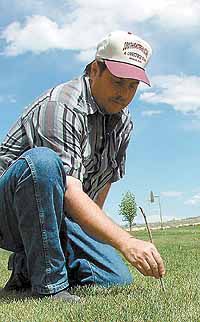| Extension Agent Marlon winger measures grass heights |
According to Marlon Winger, Utah State University Extension Agent from Carbon County the basic practices of turfgrass care include mowing, fertilization, and irrigation. In Utah, particularly eastern Utah and the Castle country, “our climate has a unique effect on the turfgrasses that we grow and proper basic care will help to keep your lawn healthy and attractive.”
The top 10 areas of consideration include:
1. Mowing
2. Keeping the roots deep
3. Frequency of mowing your grass
4. Returning clippings
5. Maintenance of fertilizer
6. Timing of fertilizer
7. Timing of irrigation
8. Aerating your lawn
9. Accept less than perfect lawn during droughts
10. How much water
Mowing
Mowing involves the top four tips for better lawns and is the most basic cultural practice for managing your lawn and is one of the easiest things that can be done to improve the grass’s appearance. Proper mowing controls most weeds, increases the density and uniformity of the turf, and helps maintain healthy plants.
It’s easy to mow properly, but there are a few things to consider. Different turfgrass species require different mowing heights, however, the commonly used turfgrass species for lawns in Utah, including buffalograss, can all be mowed at a height of three inches. According to Winger, “this may be higher than you currently mow your lawn, but there are good reasons for raising your mowing height.”
Taller grass usually means deeper roots. This is important in our cool arid climate because it allows the grass to use water that is deeper in the soil. In a drought, deeper roots can mean the difference between an attractive, healthy lawn and a thin, weak one. Consider mowing grass in shaded areas higher than in sunny areas because the higher mowing height allows more leaf area to collect available sunlight.
How often should the lawn be mowed? Just remember the “One third rule.” Ideally, the lawn should never mow more than a third of the total length of the grass blades off at a time. “For example,” explains winger, “If your lawn is a little more than four inches high, mow no lower than three inches. If your lawn is very long, its best to gradually lower the mowing height over several mowings, down to your desired mowing height.”
In practice everyone has cut an overgrown lawn down all at once and it grows fine. The key is not to repeat that practice over and over. Turfgrass is forgiving, but only a few times.
Finally, return or mulch the clippings whenever possible. These clippings return nitrogen to the soil and help decrease evaporation. Why bag and or landfill the clippings when they can save you money and be such a benefit to your lawn?
Fertilizer
To answer the question of how much fertilizer to put onto the lawn, first consider the level of maintenance and use of the lawn. In general, cool-season grasses require from two to five pounds of nitrogen per 1000 square feet per year. Rates at the higher end (four or five pounds) are for only the most intensively used and managed turfgrasses.
The higher rates may also be appropriate for play areas where the grass needs to repair itself due to traffic. A moderate level of maintenance (for a typical home lawn) requires only two to three pounds of nitrogen per 1000 square feet per year. The timing of fertilizer application is dictated by the growth pattern of the grass and it’s best to fertilize when the plants can take up the nutrients most effectively. Proper scheduling and amounts of fertilization include fertilizing in May and September for a low maintenance schedule, in May, September and November for a medium maintained lawn and in May, June, July September and November for a high maintenance lawn.
Irrigation
In this part of Utah, proper turfgrass irrigation is essential for the health of the plants and will also help to conserve our limited water supplies. There are several basic guidelines that will help.
Irrigate in early morning when temperatures are cool and the wind is not blowing to prevent evaporation losses. Avoid irrigating between 10 a.m. and 6 p.m. to minimize evaporation. Check the irrigation system monthly for leaks and damaged or clogged sprinkler heads. Mow at three inches to improve heat and drought tolerance of the grasses and aerate the lawn to improve water infiltration and reduce compaction and thatch.
Winger also says that during a drough, like we have been in for at least five years, accept a less-than-perfect lawn. During drought, grass will take on a golden color as it goes dormant but will recover as temperatures cool and water becomes available. Avoid excessive traffic on dormant turfgrass.
When puddles form or water runs off during irrigation, water in short, repeated cycles. Allow one hour in between cycles for water to move into the soil.
Adjust the irrigation controller seasonally to meet the actual water requirements of the grass. The lawn requires different amounts of water depending on the season. For example, more irrigation will be required in the summer than in the spring or fall.
“Ideally, you should apply one inch of water each time you irrigate but alternatives of less than half an inch or three quarters of an inch account for soil conditions or other limitations that you may have. Remember to shorten and increase the number of irrigation cycles if puddling or runoff occur,” reminds Winger.
In this area turf water use should include about 1.77 inches in April, 3.42 inches in May, 5,21 inches in June, 5.62 inches in July, 4.50 inches in August, 3.44 inches in September, 1.23 inches in October for a total of just over 25 inches a year.

